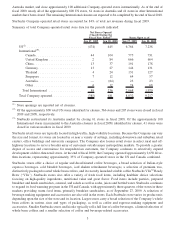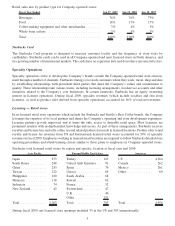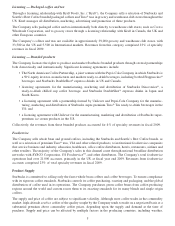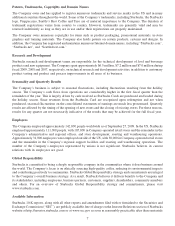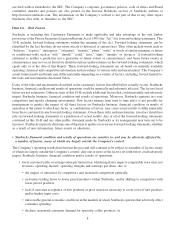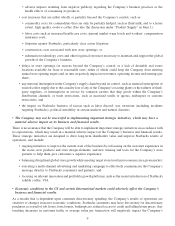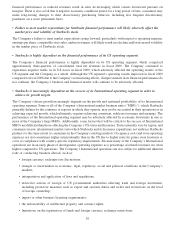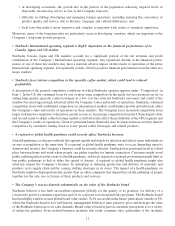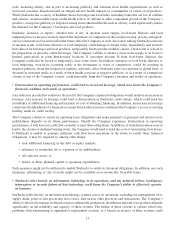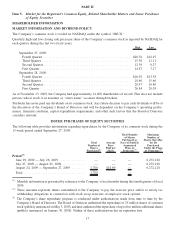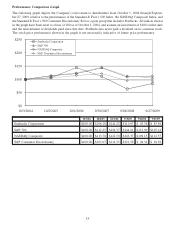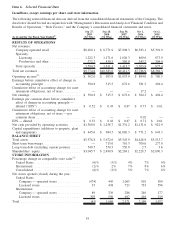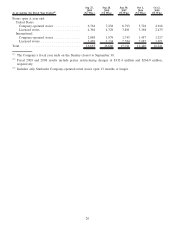Starbucks 2009 Annual Report Download - page 19
Download and view the complete annual report
Please find page 19 of the 2009 Starbucks annual report below. You can navigate through the pages in the report by either clicking on the pages listed below, or by using the keyword search tool below to find specific information within the annual report.• in developing economies, the growth rate in the portion of the population achieving targeted levels of
disposable income may not be as fast as the Company forecasts;
• difficulty in staffing, developing and managing foreign operations, including ensuring the consistency of
product quality and service, due to distance, language and cultural differences; and
• local laws that make it more expensive and complex to negotiate with, retain or terminate employees.
Moreover, many of the foregoing risks are particularly acute in developing countries, which are important to the
Company’s long-term growth prospects.
•Starbucks International operating segment is highly dependent on the financial performance of its
Canada, Japan and UK market.
Starbucks Canada, Japan and UK markets account for a significant portion of the net revenues and profit
contribution of the Company’s International operating segment. Any significant decline in the financial perfor-
mance of one of these key markets may have a material adverse impact on the results of operations of the entire
International operating segment, if not partially or fully offset by positive financial performance from the other two
major markets.
•Starbucks faces intense competition in the specialty coffee market, which could lead to reduced
profitability.
A description of the general competitive conditions in which Starbucks operates appears under “Competition” in
Item 1. In the US, the continued focus by one or more large competitors in the quick-service restaurant sector on
selling high-quality specialty coffee beverages at a low cost has attracted Starbucks customers and could, if the
numbers become large enough, adversely affect the Company’s sales and results of operations. Similarly, continued
competition from well-established competitors in international markets could hinder growth and adversely affect
the Company’s sales and results of operations in those markets. The Company faces increased competition from
larger well-known competitors which have greater resources. Increasing competition from the US packaged coffee
and tea and ready-to-drink coffee beverage markets could adversely affect the profitability of the CPG segment and
the Company’s results of operations. Given its premium brand, Starbucks may be impacted more severely than its
competitors by customers trading down to lower priced coffee beverages and related products.
•A regional or global health pandemic could severely affect Starbucks business.
A health pandemic is a disease outbreak that spreads rapidly and widely by infection and affects many individuals in
an area or population at the same time. If a regional or global health pandemic were to occur, depending upon its
duration and severity, the Company’s business could be severely affected. Starbucks has positioned itself as a third
place between home and work where people can gather together for human connection. Customers might avoid
public gathering places in the event of a health pandemic, and local, regional or national governments might limit or
ban public gatherings to halt or delay the spread of disease. A regional or global health pandemic might also
adversely impact the Company’s business by disrupting or delaying production and delivery of materials and
products in its supply chain and by causing staffing shortages in its stores. The impact of a health pandemic on
Starbucks might be disproportionately greater than on other companies that depend less on the gathering of people
together for the sale, use or license of their products and services.
•The Company’s success depends substantially on the value of the Starbucks brand.
Starbucks believes it has built an excellent reputation globally for the quality of its products, for delivery of a
consistently positive consumer experience and for its corporate social responsibility programs. The Starbucks brand
has been highly rated in several global brand value studies. To be successful in the future, particularly outside of US,
where the Starbucks brand is less well-known, management believes it must preserve, grow and leverage the value
of the Starbucks brand across its sales channels. Brand value is based in part on consumer perceptions as to a variety
of subjective qualities. Even isolated business incidents that erode consumer trust, particularly if the incidents
11




